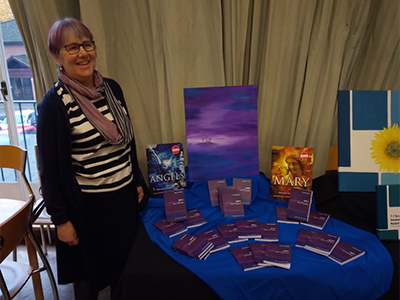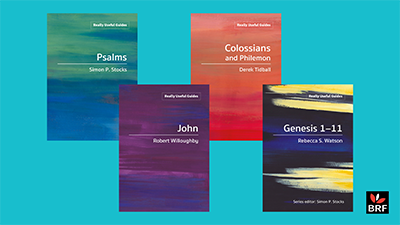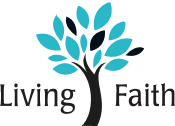Our second article on getting to know the Bible better focuses on John’s gospel, with the help of a pocket-sized guide by Robert Willoughby, Really Useful Guides: John…
17 January 2021
A Really Useful Guide
Robert wrote in the introduction to his guide:
John is my favourite book. Not just in the New Testament, nor even in the Bible – but my favourite book. Full stop. Over all the years of my conscious Christian life, it has delighted me, puzzled me, comforted me and astonished me. It has raised more questions and caused me to think more deeply and persistently than any other piece of literature. By anyone’s measurement, it stands among the truly great achievements of the human spirit and ranks among the greatest literature ever created. I may be exaggerating there, but I don’t think so.
He goes on to give four specific reasons why John is so important and engaging.
- It’s got the best stories. The wedding feast at Cana, Nicodemus, Jesus meeting the Samaritan woman, the man born blind, the raising of Lazarus – all before you’re half way through.
- John has some of the most memorable and delightful characters: they ask questions, have opinions and feelings, and clearly experience the normal reactions to life that we all do. We feel we can know them.
- John’s focus is constantly upon Jesus. It is a wonderful portrait of Christ, and it directly draws out his importance and his magnetism without any hesitancy or uncertainty. The reader is overwhelmed by the central character.
- John always deals with important issues. This is always true of the Bible, but that’s what makes this book in particular so gripping. John gets straight to the theological heart of what matters about God sending Jesus.
Sadly, Robert died suddenly just before his book was published. But his wife, Ro, another popular BRF writer who contributes to a number of our Bible reading notes, went ahead with a poignant but very special launch at the London School of Theology. This deceptively slight little book is a very special part of Robert’s legacy.
The following extracts are from Chapter 1.
Beginning at the beginning
Do you know the beginning of Stanley Kubrick’s 1968 film 2001: A Space Odyssey? Very dramatically and seriously, the film opens with a shot of the earth from outer space, accompanied by majestic music, and moves to the creation of humanity on the earth.
John’s gospel has a somewhat similar opening. Its first 18 verses take us outside of time and set the story of Jesus against the backcloth of creation, the story of Israel and the coming of the Messiah.
‘These verses introduce many of the themes that are important as we read the gospel. They are poetic and deeply philosophical.’
These verses introduce many of the themes that are important as we read the gospel. They are poetic and deeply philosophical, take a broad theological perspective and place the incarnation, as it should be placed, in the context of creation. Indeed, not a few scholars have suggested that the stories of Genesis constitute an essential background to reading John.
In the beginning was the Word, and the Word was with God, and the Word was God. He was with God in the beginning. Through him all things were made; without him nothing was made that has been made.
John 1:1–3
The Word was with God, and the Word was God
In the first five verses Jesus is identified as logos, a common Greek word meaning ‘word’. Jesus was God’s eternal Word, his active agent by which he created the whole universe. God speaks, communicating through his creation and to it. This is revelation and John is very interested in this theme.
‘Jesus was God’s eternal Word, his active agent by which he created the whole universe.’
People don’t always want to hear, which is why John describes how Jesus, the Word, has constant opposition from the Pharisees and those people he simply refers to as ‘the Jews’. Even his own followers frequently misunderstand him, so he has to further explain what he is doing or saying. This often leads to highly ironic situations where we, as readers, understand what is going on, but the people in the gospel do not. Sometimes you even want to laugh, but feel you shouldn’t. Indeed, if we had been there, we’d have made the same stupid mistakes.
Jesus is the source of light and life – themes taken up a number of times in John’s account of the life of Jesus. Not for the last time, Jesus is identified as closely as possible with God Almighty, the creator and sustainer of all things.
The light shines in the darkness
In John 1:5 we read, ‘The light shines in the darkness, and the darkness has not overcome it.’ This is actually a piece of wordplay, a double meaning, which is typical of John. The Greek word translated ‘overcome’ by the NIV (and indeed, it can mean that or ‘dominated’) can also mean ‘understood’. So John manages to convey two ideas at one and the same time: that darkness tries but fails both to understand the light and to overcome or suppress it.
Contents of Really Useful Guides: John
To give you a sense of the range and depth contained in this little book, here’s a list of all the questions it covers:
- Beginning at the beginning
- What to look out for
- Puzzling things about John
- When was John written?
- Why did John write?
- Who wrote John?
- Community origins?
- An overview of the gospel of John
- A more detailed guide to the gospel
- Introducing Jesus (1:1–51)
- From Cana to Cana (2:1—4:54)
- A tour of the festivals (5:1—8:59)
- Gathering the sheep (9:1—12:50)
- The last supper and Jesus’ farewell conversations (13:1—17:26)
- The betrayal, arrest, trial, crucifixion and burial (18:1—19:42)
- The resurrection of Jesus (20)
- The epilogue (21)
- John and other New Testament writings
- John and the other gospels
- John and the Old Testament
- The rest of the New Testament
- John’s continuing message
- Main themes
- How should we teach and preach from John today
- Further reading
Robert Willoughby taught New Testament and political theology at the London School of Theology for over 30 years and more recently served as a priest in the Church of England. Able to communicate complex truths across all ages, his books include Children’s Guide to the Bible and So, Who Is God?

Sadly, Robert died suddenly just before Really Useful Guides: John was published. His wife Ro (pictured), along with friends and colleagues, launched the book at the London School of Theology in November 2019.

For straightforward, accessible guides to individual books of the Bible see our range of pocket-sized Really Useful Guides, including:
– Genesis 1-11
– Psalms
– John
– Colossians and Philemon
Buy a pack of all four guides at the special price of £20.00.
Also coming 22 January (in Kindle edition only):
– Genesis 12-50
– Romans
‘The books in this series are described as “not a commentary and not an introduction”. Taking about two hours to read, they are a valuable extra tool for acquiring general biblical literacy, understanding some of the more obscure passages in the scriptures, and help in using them to find messages for today.’
Claire Disbrey, licensed lay minister, diocese of London

Find out more about our Living Faith ministry, and the wide range of resources we publish.
